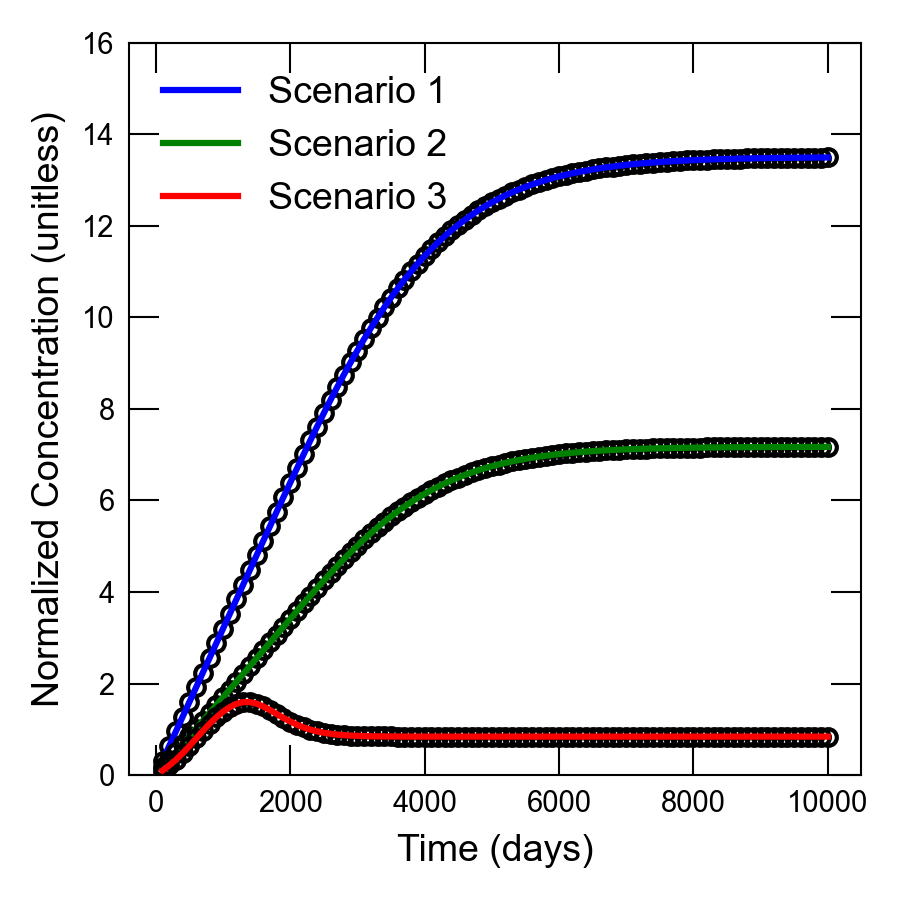47. MT3DMS Supplemental Guide Problem 6.3.2
This example is for zero-order production in a dual-domain system. It is based on example problem 6.3.2 described in (Zheng, 2010). The problem consists of a one-dimensional model grid with inflow into the first cell and outflow through the last cell. This example is simulated with the GWT Model in MODFLOW 6, which receives flow information from a separate simulation with the GWF Model in MODFLOW 6. This example is designed to test the capabilities of the GWT Model to simulate zero-order production in a dual-domain system with and without sorption. Results from the GWT Model are compared with the results from a MT3DMS simulation (Zheng, 1990) that uses flows from a separate MODFLOW-2005 simulation (Harbaugh, 2005). This example was described by (Zheng, 2010) who showed that the results from MT3DMS were in good agreement with an analytical solution.
47.1. Example description
The parameters used for this problem are listed in Table 47.1. The model grid consists of 401 columns, 1 row, and 1 layer. The flow problem is confined and steady state with an initial head set to the model top. The solute transport simulation represents transient conditions, which begin with an initial concentration specified as zero everywhere within the model domain. A specified flow condition is assigned to the first model cell. For the source pulse duration, a specified concentration with a value of one is assigned to the first model cell. Following the source pulse duration the specified concentration in the first cell is zero. A specified head condition is assigned to the last model cell. Water exiting the model through the specified head cell leaves with the simulated concentration of that cell.
Parameter |
Value |
|---|---|
Number of periods |
2 |
Number of layers |
1 |
Number of rows |
1 |
Number of columns |
401 |
Column width (\(m\)) |
2.5 |
Row width (\(m\)) |
1.0 |
Top of the model (\(m\)) |
1.0 |
Layer bottom elevation (\(m\)) |
0 |
Specific discharge (\(md^{-1}\)) |
0.06 |
Longitudinal dispersivity (\(m\)) |
10 |
volume fraction that is immobile domain (unitless) |
0.2 |
Porosity of mobile domain (unitless) |
0.2 |
Porosity of immobile domain (unitless) |
0.05 |
Bulk density (\(gL^{-1})\) |
4.0 |
First-order mass transfer rate between the mobile and immobile domains (\(d^{-1}\)) |
1.0e-3 |
Fraction of sorption sites in contact with mobile water (unitless) |
0.8 |
Source duration (\(d\)) |
1000 |
Simulation time (\(t\)) |
10000 |
Observation x location (\(m\)) |
200.0 |
47.2. Example Scenarios
This example problem consists of several different scenarios, as listed in Table 47.2. The first two scenarios represent zero-order growth when sorbtion is active. Sorbtion is not active in the last scenario. For all three scenarios, there is mass transfer between the mobile domain and the immobile domain.
Scenario |
Scenario Name |
Parameter |
Value |
|---|---|---|---|
1 |
ex -gwt-mt3dsupp632a |
distrib ution coefficient (: math:mL g^{-1}) |
0.25 |
decay (:ma th:g/mL d^{-1}) |
0.0 |
||
decay sorbed (:ma th:g/mL d^{-1}) |
-0.001 |
||
2 |
ex -gwt-mt3dsupp632b |
distrib ution coefficient (: math:mL g^{-1}) |
0.25 |
decay (:ma th:g/mL d^{-1}) |
-0.0005 |
||
decay sorbed (:ma th:g/mL d^{-1}) |
-0.0005 |
||
3 |
ex -gwt-mt3dsupp632c |
distrib ution coefficient (: math:mL g^{-1}) |
0.0 |
decay (:ma th:g/mL d^{-1}) |
-0.001 |
||
decay sorbed (:ma th:g/mL d^{-1}) |
0.0 |
47.2.1. Scenario Results
Results from the three scenarios are shown in Figure 47.1. The close agreement between the simulated concentrations for the MODFLOW 6 GWT Model and MT3DMS demonstrate the zero-order growth and immobile-domain transfer capabilities for MODFLOW 6.

Figure 47.1 Concentrations simulated by the MODFLOW 6 GWT Model and MT3DMS for zero-order growth in a dual-domain system. Circles are for the GWT Model results; the lines represent simulated concentrations for MT3DMS.
47.3. References Cited
Harbaugh, A. W. (2005). MODFLOW-2005, the U.S. Geological Survey modular ground-water model—the Ground-Water Flow Process. Retrieved from https://pubs.usgs.gov/tm/2005/tm6A16/
Zheng, C. (1990). MT3D, a modular three-dimensional transport model for simulation of advection, dispersion and chemical reactions of contaminants in groundwater systems.
Zheng, C. (2010). MT3DMS v5.3—a modular three-dimensional multi-species transport model for simulation of advection, dispersion and chemical reactions of contaminants in groundwater systems; supplemental user’s guide.
47.4. Jupyter Notebook
The Jupyter notebook used to create the MODFLOW 6 input files for this example and post-process the results is: